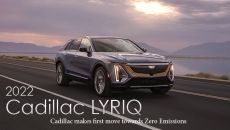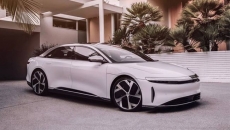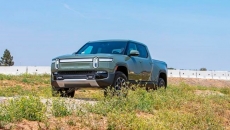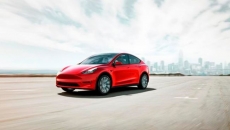CES, formerly known as the Consumer Electronics Show, in Las Vegas continues to provide a sneak peek at future technology. The annual showcase includes advanced automotive tech in an industry striving to reduce pollution and increase occupant safety while also providing greater convenience and entertainment for road warriors. These are the most impressive innovations we saw at this year’s event.
Dash-spanning displays from BMW
What kind of screens and technology can you expect to see in new vehicles in the coming years? BMW’s all-new in-cabin digital interface, dubbed Panoramic iDrive, gives us a compelling preview.
Panoramic iDrive has a digital display at the base of the windshield spanning the entire dashboard. This display is called Panoramic Vision, and it projects everything from speed to EV range to navigation guidance, along with climate and audio info. This display pairs with an easy-to-reach central touchscreen and advanced head-up display that can project 3D-like information on the windshield for the driver. BMW also showcased a new squared-off steering wheel with illuminated buttons that the company says are very easy to use.
We expect Panoramic iDrive will debut in upcoming BMW vehicles in late 2025.
New EVs and easier public charging from Honda
Honda jumped into the deep end of the electric vehicle pool at CES 2025 with the debut of two all-new, all-electric models. The Honda 0 SUV and 0 Saloon are based on two wild-looking concept cars shown at last year’s CES, yet these production-ready models haven’t lost any of their aggressive style and will definitely turn heads when they arrive in 2026.
Both will be built in Ohio and will be capable of Level 3 automated driving functionality, meaning drivers will be allowed to drive hands-free and take their eyes off the road for short periods of time when specific environmental conditions are met. Honda says these 0 models will also use a new technology interface, called Asimo, that will provide a high degree of personalization to customize the driving experience for each user.
The launch of the 0 SUV and 0 Saloon will coincide with Honda’s effort to improve charging access to drivers through a joint effort with seven other automakers. The goal is to have 30,000 high-speed charging stations built in North America by 2030. These stations will have plugs with the Tesla-style North American Charging Standard, or NACS, which most automakers have been switching to.
Better internet connectivity while on the move
Even in 2025, getting consistent and stable internet service can be a challenge. We can access the information superhighway through Wi-Fi networks, cellular service or satellite signals, though all three have limitations and are certainly not 100% reliable.
But what if you could combine the power of satellite, cellular and Wi-Fi networks into a single pipeline of internet service? And what if that pipeline could constantly evaluate and optimize the data stream as you travel between signal sources? That’s exactly what Stellar, a new company from France, is offering. The company is working with automakers to optimize mobile service by using hardware already built into today’s cars. The end goal is to have improved, more consistent high-speed internet access in your vehicle, whether you’re going through a city tunnel or driving across the open plains.
Toyota weaves the city of the future
Toyota’s vision for the future of mobility goes beyond EVs and self-driving cars. The company is engineering a complete city environment in Japan where everything from building construction to food supply to education and transportation are coordinated for maximum efficiency and minimal environmental impact. The areas of focus include personal transportation, and the company’s massive site, called Woven City, will serve as a test course for automated tech development.
Woven City will scale from an initial 50,000 square miles up to 700,000 square miles as construction continues. By the fall of 2025, it will provide housing for about 360 Toyota staff and family members and eventually expand to 2,000-plus residents, including Woven City partner companies involved in construction, food and drink, education and even rocket production.
While it’s hard to predict what will come out of Toyota’s Woven City that will actually end up in production vehicles, it’s fair to say that Toyota will have a head start on how to leverage various new technologies best.
Edmunds says
Full self-driving cars have yet to appear, but automakers are chipping away at this elusive tech while making clear progress in advanced user interfaces, electric vehicle design, and even comprehensive city planning. While the last few years have seen moderate progress in these areas, it feels like we’re on the cusp of multiple breakthroughs in the automotive space.






